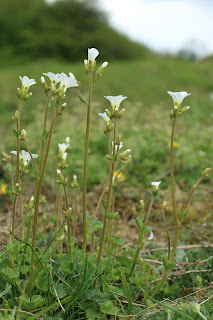 |
| Greater Butterfly Orchid, Bald Hill 5.6.19 |
 |
| Lesser Butterfly Orchid, Cae Blaen Dyffryn 15.6.19 |
 |
| Hybrid, Warburg 16.6.19 |
I put all the data together, from 22 locations together with summaries from Skye and the Chilterns.
It includes some hybrids, mainly from Gloucestershire, but there is one from Warburg. Altogether there are 224 observations for lesser and greater and 16 for the hybrid, (excluding Skye and the Chilterns studies) though not necessarily including all parameters for each observation
The data is very variable, but as might be expected there are clear differences between lesser and greater butterfly orchids, and indeed the hybrid. A few examples of the averages (the differences have not been subjected to any statistical tests)
Ratio of number of flowers to height
LBO 0.70
GBO 0.35 to 0.53
Hybrid 0.69
Subtended angle between the pollinia
LBO 4 degrees
GBO 37 degrees
Hybrid 15 degrees
Labellum width to height
LBO 0.30
GBO 0.24
Hybrid 0.26
Spur length
LBO 20.8mm
GBO 27.1 to 33.8mm
Hybrid 25.3mm
Spur length is dependent on latitude, but not to the extent I expected; the further north the shorter the spur, but shading also seems to have an impact - shaded plants have longer spurs. Plant height is affected by shading, but also by environment and latitude. The Chilterns woodland greater butterfly orchids are taller than average, but have fewer flowers than would be expected for their heights. Bald Hill, an open site, part of the Aston Rowant NNR, has stunted greater butterfly orchids yet is only a few miles from the Chilterns woodland site.
The plant with the longest spur though was a hybrid from Warburg at 40mm (pictured above), reminiscent of long spurred orchids found in Holland, but as there was only 1 plant and it did not re-emerge this year, then all I can assume that it is simply a natural variation















































